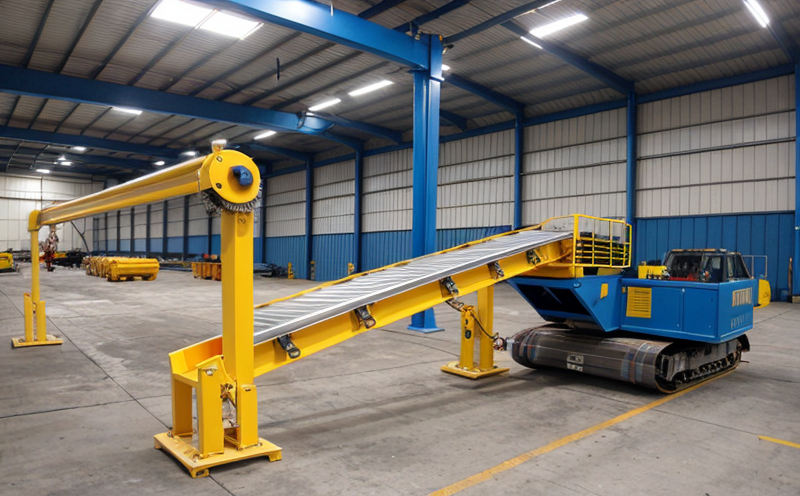MSHA Certification Testing of Wire Ropes for Lifting Systems
The Mine Safety and Health Administration (MSHA) is a United States federal agency responsible for ensuring safe and healthful working conditions in mines. MSHA regulations require that wire ropes used in lifting systems within mining operations meet specific standards to ensure safety and reliability. This section outlines the testing procedures, equipment, and acceptance criteria necessary to achieve MSHA certification for wire ropes.
The primary objective of MSHA certification testing is to verify that wire ropes are suitable for their intended use in lifting systems. The testing process involves several stages: specimen preparation, mechanical testing, inspection, and final certification. Specimens are typically cut from the actual wire rope used in mining operations, ensuring that the test results accurately reflect real-world conditions.
The mechanical tests include tensile strength, fatigue resistance, and static load testing. Tensile strength is measured to ensure the wire rope can withstand the maximum expected loads without breaking. Fatigue resistance tests simulate the cyclic loading conditions encountered during regular use in mining operations. Static load testing assesses how the wire rope behaves under sustained loads over extended periods.
Inspection plays a critical role in MSHA certification testing. Visual inspections are conducted to identify any visible defects, such as nicks, cuts, or surface irregularities. Non-destructive testing methods like ultrasonic testing and magnetic particle inspection may also be employed to detect internal flaws that could compromise the integrity of the wire rope.
The acceptance criteria for MSHA certification are stringent and are based on international standards such as ASTM F1219-18, ISO 4303:2016, and EN 12751. These standards provide detailed specifications for the testing procedures, specimen preparation, and acceptable limits for mechanical properties.
The results of these tests are meticulously recorded and analyzed to ensure compliance with all MSHA requirements. A comprehensive report is generated, detailing the test parameters, results, and any deviations from accepted criteria. This report serves as evidence that the wire rope meets the necessary safety standards and can be used in mining operations without compromising safety.
The importance of MSHA certification cannot be overstated. In the event of an accident or incident, compliance with these regulations is critical for demonstrating due diligence and adherence to best practices. MSHA certification ensures that lifting systems are reliable, safe, and capable of performing their intended functions under all expected conditions.
Benefits
The benefits of obtaining MSHA certification for wire ropes used in mining operations extend beyond regulatory compliance. By ensuring that the wire rope meets rigorous safety standards, mines can significantly reduce the risk of accidents and injuries. This not only enhances the overall safety of the workforce but also helps to minimize potential legal liabilities.
Obtaining MSHA certification also demonstrates a commitment to best practices in safety management systems (SMS). This can enhance an organization's reputation within the industry, making it more attractive to potential clients and partners. Additionally, compliance with these standards reflects a proactive approach to risk management, which is increasingly valued by stakeholders.
From a practical standpoint, MSHA certification ensures that wire ropes are capable of performing their intended functions under all expected conditions. This reduces downtime due to failures and extends the useful life of the equipment. Regular testing and maintenance programs supported by MSHA certification can help identify potential issues early, allowing for timely repairs or replacements.
The long-term benefits of MSHA certification extend beyond immediate safety improvements. By investing in quality assurance through rigorous testing procedures, mines can build a culture of excellence that permeates all aspects of operations. This can lead to increased efficiency, reduced costs associated with accidents and injuries, and enhanced productivity across the entire organization.
Industry Applications
The MSHA certification process for wire ropes is particularly important in mining applications where lifting systems are critical to operational success. These systems include hoists, conveyors, cranes, and other equipment used to transport materials within underground or surface mines.
In underground mining operations, wire ropes are often used in hoisting systems that lift materials from the depths of the mine to surface-level processing facilities. These systems must be reliable and safe due to the extreme conditions they operate in, including high humidity, temperature fluctuations, and exposure to corrosive environments. MSHA certification ensures that these lifting systems meet the highest safety standards.
In surface mining operations, wire ropes are used in conveyor belts to transport bulk materials over long distances within a mine site or between different processing facilities. The reliability of these systems is crucial for maintaining continuous production, and MSHA certification provides assurance that they can perform safely under all expected conditions.
The certification process also applies to other lifting equipment such as cranes used in various mining operations. These cranes must be able to lift heavy loads with precision and safety, making MSHA certification an essential requirement for their use in mining environments.
Environmental and Sustainability Contributions
The pursuit of sustainability has become a priority across industries, including mining. By ensuring that wire ropes used in lifting systems meet the highest safety standards through MSHA certification, mines can contribute to environmental and sustainability goals in several ways.
Firstly, by reducing accidents and injuries, MSHA certified equipment helps minimize waste associated with worker compensation claims and medical expenses. This not only lowers operational costs but also contributes to a healthier workforce, which is crucial for maintaining productivity levels over the long term.
Secondly, ensuring that lifting systems are reliable and safe through regular testing programs supported by MSHA certification can help reduce downtime due to failures. This leads to more efficient operations and reduced energy consumption, contributing positively to environmental sustainability efforts.
Finally, compliance with MSHA standards reflects a commitment to responsible resource management. By investing in high-quality materials and rigorous testing procedures, mines demonstrate their dedication to minimizing waste and optimizing the use of resources throughout the entire mining process.





